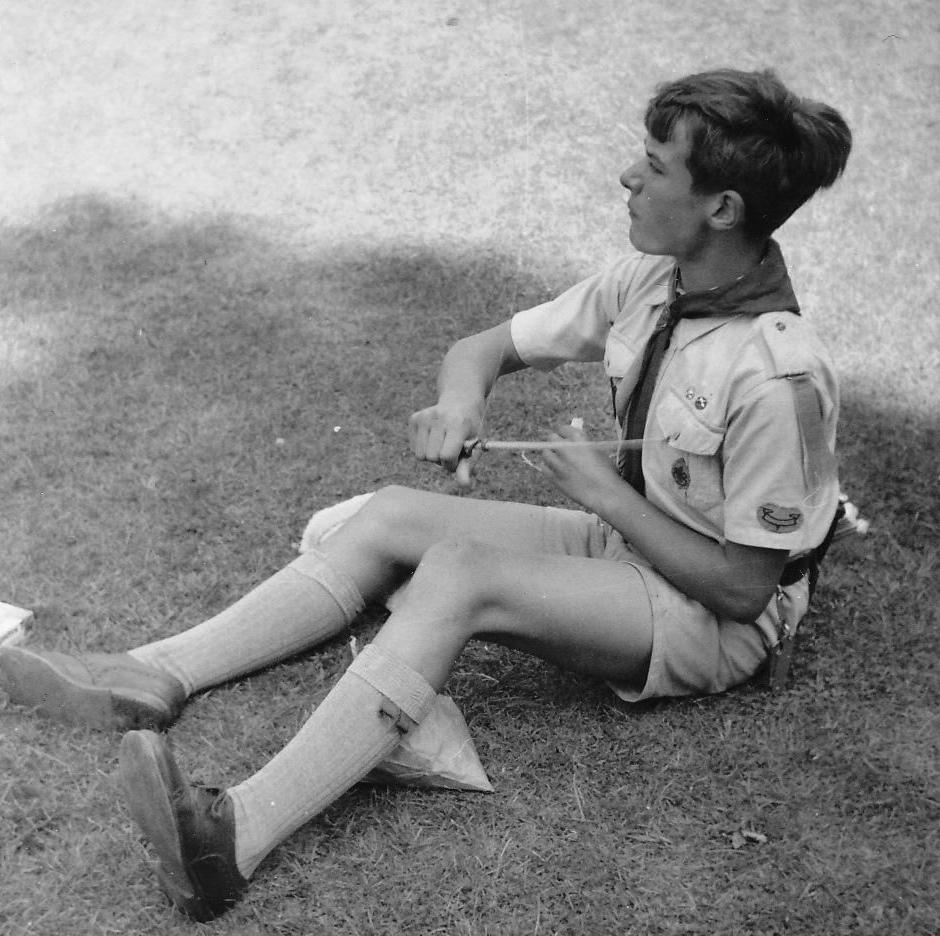
English Boy Scout Uniforms: Levels

Figure 1.--This English Scout is participating in the Newbury Scout Camp at Avening in 1963. He is wearing the complete uniform except for the beret. Note that Scouts in the 1960s still commonly wore leather shoes. We are nt site what he is doing, but he appears to be ulling on a whistle.
|
|
The basic organization of Scouting was set in England with the creation of the Scouts in 1906 and a yoonger boys were also interested, the addition of cubbing in 1916. Than Rovers for older boys were added. The organizatand has remained unchanged except for the cretion of Beaver Scouts in 19??. The garments included a lemon-squeezer hat, shirt with flap pockers and epaulettes, neckerchief, darker short pants, and knee socks. Many of these garments are still associated with Scoutung. Most countries initially adopted the British system, although some countries changed the names. The Scout Association from an eaely point decided when they created Cubbing, that the Boys at the diffrent levels should have desstinctiuve uniforms, in part so the older boys' programs would not be confused with the younger boys. The Cubs adopted a green peaked cap with yellow trim which became a standard around the world, although some countries changed the color. The Scout lemon squeezer hat and the Cub peaked cap became iconic symbols of Scouting not only in Britain, but around the world.
Beavers
Baden Powell chose a theme based on Kiplings Jungle Book, it proved wildly popular with the boys--even if it is now often made fun of in our more cynical age. The English Cub uniform spread around the world. Some countries used it virtually unchanged. Others like America changed it significantly. One comstant in most countries was the Cub cap, just as Scouts in most countries used the original Scout hat for decades. The uniform adopted for English Cubs in 1916 was worn by English boys for decades virtually unchanged. It was adopted by Cubs all over the world although it was gradually modified and changed. In England, however, it has continued virtually unchanged. The only major change has been in the pants and kneesocks the boys have worn. The Wolf Cubs began operating in 1916. The uniform designated for Cubs in 1916 was worn by English boys for decades virtually unchanged. It was subsequently adopted by Cubs all over the world although it was gradually modified and changed. In England, however, it continued virtually unchanged.
Scouting was founded in England during the 1906. Lord Baden Powell fresh from South Africa and the Boer War chose a military-style uniform. The garments included a lemon-squeezer hat, shirt with flap pockers and epaulettes, neckerchief, darker short pants, and knee socks. This uniform became a standard for Scouts as other natiinal programs were founded. Many adopted the samevbasic uniform that British Scouts wore. Only gradually did destinctive national uniforms appear. English Scouts wore this samevbasic uniform for some time. Knee pants were common for boys at the time, but the similar short pants began a substantial change in boyswear in Britain and other countries. English Scouts made some major changes in their uniform in the 1940s, 50s, and 60s. Scouts in the 1940s wore blue shorts and blue kneesocks. During the 1950s a change to an all khaki uniform was made. The English Scouts unlike America did not have a summer and winter uniform. The uniform called for short pants and keesocks throughout the year. The Scout Association's Chief Scouts at that time, Lord Maclean, in 1969 set up an Advance Party to determine how to modernize Scouting and better appeal to boys. The outcome was to change English Scouting for ever. The Association got rid of the names Wolf cubs and Boy Scouts for Cubs and Scouts. He put all the Scouts in to long pants by changing the uniform that was set out by Baden-Powell to a new uniform of green long sleeved shirts and mushroomed coloured long pants. Some English Scouters, at this time, broke away from the main-linw Scout Association and formed the Baden-Powell Scouts Association. Since 1969, the English Scout uniform as stayed roughly the same. They were allowed to get rid of their berets, green shirts and mushroomed pants for green sweatshirts and school pants.
Rovers
HBU

Navigate the Historic Boys' Uniform Chronology Pages:
[Return to the Main chronologies page]
[The 1900s]
[The 1910s]
[The 1920s]
[The 1930s]
[The 1940s]
[The 1950s]
[The 1960s]
[The 1970s]
[The 1980s]
[The 1990s]
[The 2000s]
Navigate the Historic Boys' Uniform Web Site:
[About Us]
[Activities]
[Biographies]
[Chronologies]
[Countries]
[Essays]
[Garments]
[Organizations]
[Religion]
[Other]
[Introduction]
[Bibliographies]
[Contributions]
[FAQs]
[Questions]
[Unknown images]
[Boys' Uniform Home]
Navigate the Historic Boys' Uniform Web organization pages:
[Return to the Main English Scout page]
[Return to the National Scout page]
[Boys' Brigade]
[Camp Fire]
[Hitler Youth]
[National]
[Pioneers]
[Royal Rangers]
[Scout]
Created: April 11, 2002
Last updated: April 11, 2002



